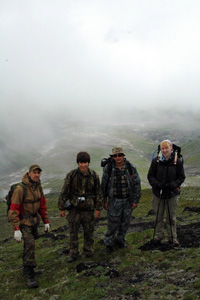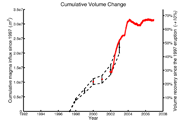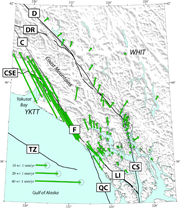ISEA is an international US-Japan project to study glacial-isostatic adjustment (GIA), commonly called "post-glacial rebound", and hydrologic loading variations in Southeast Alaska. This project builds on a decade of past research at UAF, which has shown that post-Little Ice Age deglaciation causes rapid uplift, at rates in excess of 30 mm/yr in places. Since 2009, we have had funding from the National Science Foundation to continue this work, and use the land-based data along with data from the GRACE satellite mission to study the seasonal hydrological cycle in Southeast Alaska.
I am working with Dr. Anthony Arendt (also at UAF) to use the seasonal variations in the continuous GPS data along with data from NASA's GRACE satellites to study the accumulation and melt of snow and ice in the region. The figure that is attached shows the motion of one of the GPS sites. The top two panels are the horizontal position as a function of time, which show a pretty much linear trend. The bottom panel shows the vertical, and in addition to showing an average uplift rate of about 2 centimeters per year, you can see very obvious seasonal variations. Relative to the average rate, the site subsides in winter and uplifts in summer. This is a result of the accumulation and melt of snow in addition to the net loss of glacier ice.
Dr. Jeffrey T. Freymueller
Professor of Geophysics
Geophysical Institute
University of Alaska, Fairbanks
Fairbanks, AK 99775-7320




